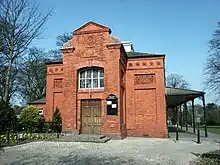Marianne Brocklehurst
Marianne Brocklehurst (1832–1898) was an English traveller and collector of Egyptian antiquities. She supported a number of Egyptian excavations and donated most of her collection of antiquities to the West Park museum in Macclesfield.

Personal life
Brocklehurst was one of the eight children of John Brocklehurst, a wealthy Macclesfield silk manufacturer.[1]
In 1861 she accepted a marriage proposal from one Henry Coventry, a distant relation of the Earls of Coventry, but her father declined consent; Brocklehurst broke off the engagement.[2] She never married, but from the 1870s shared her life with her companion Mary Booth. Brocklehurst and Booth shared a home, 'Bagstones', at Wincle outside Macclesfield.
Brocklehurst died in London in 1898. It is thought she committed suicide.[3] Booth inherited the property and lived there until her own death in 1912. They are buried in the same grave, with a joint gravestone, in the churchyard at Wincle.[3]
Egyptology

In 1873 Marianne Brocklehurst and Mary Booth ('the two MBs') visited Egypt.[4] While in Egypt, she met Amelia Edwards, another English traveller, and the two parties travelled together in a flotilla up the Nile. Edwards later published her account of the journey in the bestselling A Thousand Miles up the Nile (1877). Brocklehurst's own travel diary of the voyage was published in 2005.[5][6] Brocklehurst and Edwards competed with each other in the illegal extraction of antiquities from Egypt.[7][8] Brocklehurst and Booth returned to Egypt in 1876–1877, in 1883[9] and then for a final time in 1890–1891.[3] On the final trip they witnessed the removal of a large quantity of recently removed 21st Dynasty mummies from Thebes.[3]
Brocklehurst was a funder of excavation efforts. She contributed to Edwards' Egypt Exploration Fund, and was an early subscriber to the fund-raising efforts of Flinders Petrie.[3] Through these connections she acquired a number of artefacts. Brocklehurst offered funding to the local council to build a museum to hold these objects, and as a result Macclesfield's West Park museum was opened in 1898.[3] There was some dispute between the Brocklehursts and the council about the building of the museum,[10] and she remained in London on the opening day.[3]
References
- Whistow, Thelma (2004). Marianne Brocklehurst : benefactor, explorer, artist : her life and times 1832-1898. Macclesfield Museums Trust. Macclesfield: Macclesfield Museums Trust. ISBN 978-1870926447. OCLC 56774718.
- Bray, Jean (2004). The Lady of Sudeley. Sutton Publishing Ltd. p. 70. ISBN 0750937203.
- Serpico, Margaret (2015). Beyond Beauty (PDF). Two Temple Place.
- Rushby, Pamela (2015). "MISS BROCKLEHURST AND THE WEST PARK MUSEUM" (PDF). Nova.
- 1832-1898., Brocklehurst, Marianne (2004). Miss Brocklehurst on the Nile : diary of a Victorian traveller in Egypt. Disley: Millrace. ISBN 978-1902173146. OCLC 57209390.CS1 maint: numeric names: authors list (link)
- "Ancient Egypt Magazine - Reviews". www.ancientegyptmagazine.co.uk. Retrieved 2018-10-27.
- "Ancient Egypt Magazine - Reviews". www.ancientegyptmagazine.co.uk. Retrieved 2018-10-27.
- Hilary, Forrest (2011). Manufacturers, mummies, and Manchester : two hundred years of interest in and study of Egyptology in the Greater Manchester area. Oxford, England: Archaeopress. ISBN 978-1407307886. OCLC 727021178.
- Dawson, Warren (Dec 1947). "Letters from Maspero to Amelia Edwards". The Journal of Egyptian Archaeology. 47: 66–89. doi:10.1177/030751334703300110. JSTOR 3855441. S2CID 192237250.
- Griffiths, Sarah Jane (2006). The charitable work of the Macclesfield silk manufacturers, . (PDF).